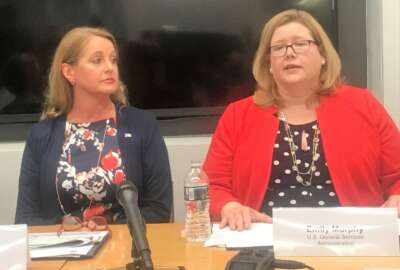
When it comes to shared services, Labor isn’t eating the apple in one bite
The Labor Department is moving from 13 different HR offices, 26 different IT application organizations, four different procurement organizations and numerous pe...
Let’s get the obvious out of the way first — making shared services work governmentwide is hard.
Over the last 20 or so years, the number of successes you can point to could be counted on one hand. There’s the payroll consolidation effort under the Bush administration, the Department of Housing and Urban Development’s move to the Treasury Department’s financial management provider on a limited basis, Treasury’s electronic invoicing program and there are a few others in the cybersecurity realm with small and micro agencies.
But generally speaking, unless there is a mandate from the Office of Management and Budget — see payroll and e-invoicing — then getting agencies to give up control, change business processes and trust public or private sector providers is, well, hard.
As OMB and agency leaders kick off the latest shared services effort, the Quality Service Management Organizations (QSMO), maybe it’s time to revisit some historical concepts because the administration seems to be reluctant to mandate change in this realm.
Success in shared services comes back to simple sayings from the early 2000s. As Mark Forman, the former OMB administrator for e-government and IT, used to preach, “Don’t try to boil the ocean,” and “Don’t try to eat the apple in one bite.”
To translate, start small and build off of successes.
Commerce avoids spending $50 million
In the case of shared services, the idea is to start internally and expand externally, and there are more examples of this concept working than the let’s-move-to-a-public-or-private-sector-provider-in-one-fell-swoop concept.
The Commerce Department’s shared service efforts is an example of that. In the agency’s fiscal 2018 performance report to Congress, it says some of the benefits of enterprise services included taking ownership of the learning management system to standardize and reduce duplication, transitioned every bureau without procurement authority into the ES procurement line of business, which sped up acquisition of goods and services and resulted in nearly $50 million in cost avoidance through strategic sourcing; and processed nearly 2,500 contract transactions with an average requisition-to-order time of 19.5 days or less.
NASA is another example of taking on internal consolidation and shared services before looking outside. The space agency, for example, consolidated data centers and provides one financial management system for the entire agency through its shared services center at the Stennis Space Center in Mississippi.
And now the Labor Department is finding success with an internal consolidation of back-office functions first.
“We are creating a shared service environment within our department. That would position us well, very well in some future period of time to then look at external providers that may be able to do this even better than we can provide it to ourselves,” said Traci Smith, a program manager at the Labor Department, during the 2019 Shared Services Summit, sponsored by the Association of Government Accountants, the Shared Services Coalition and ACT-IAC in Washington, D.C. “But in order to get there, we need to have standardization from within. I can’t even imagine how we would get to the table today and negotiate 13 different human resources offices moving one provider. It would be a difficult process for that provider and it would be challenging for us.”
To that end, Labor is consolidating all back-office operations:
- 13 different HR organizations into one
- 26 or so IT application organizations into one
- Three to four different procurement organizations into one
- Numerous personnel security organizations that provide part of the security clearance and background investigation process into one.
“The basic methodology that we utilized was agile and modifiable throughout the process because every agency within DoL is very different,” Smith said. “We had a huge engagement effort. It almost took an entire year to engage all the stakeholders. Even when we thought we were done, we weren’t done. We had so much more feet on the pavement to talk to people, and even then we didn’t feel like it was enough. We did a lot of strategy, analysis and discovery to understand how these organizations operate today.”
Workgroups and the voice of the customer
Since 2017 when Labor started this consolidation effort, Smith said all HR offices should be transitioned to one service provider by the end of the calendar year. Procurement and IT also are making significant progress with completion scheduled for early-to-mid 2020. She said the integration of the personnel security offices also is mostly complete.
“IT is the largest piece with 26 or so sub-organizations within the department. While we have made a lot of headway, we have the rest of this fiscal year to really make significant change and finalize it,” Smith said. “We have been very thoughtful as to who we incorporate into which phase. We mix it with some of the more challenging agencies or maybe the resisters to change with maybe some of the change advocates or those who are not adverse to the idea.”
Smith said one reason Labor has been making progress is it relied on workgroups in each back-office area with subject matter experts to address business process changes.
“Everyone starts and ends the process the same way, but how we get there is vastly different, so we really are coming up with that one best way that we can all live with,” she said. “What we are finding now, post-implementation, what we thought maybe was the best way, we need to dust off, look at it again and refresh. Now that people are in their permanent placements within the organization, we can get a little more traction and impact more change.”
Smith added that the amount of change management her office needed to do was much more than expected. She said creating the trust relationship with the organizations was, in many cases, more important that the data around saving money and better services.
Latest Technology News
It’s important not to overlook Labor’s steps. There’s no discussion about moving off premise. There was no discussion about forcing the proverbial square peg into the round hole. Labor started small, brought together those who are effected to reach an agreement on what the future state of HR or IT will look like, and then started the consolidation.
The QSMOs are trying to replicate many of the things Labor found successful, but the concern is the scale. It’s one thing to bring almost two dozen bureaus and offices from the same agency together, but it’s a much bigger lift to bring 24 separate departments together to agree to grants processes or human resources processes.
It would make sense to follow Commerce, NASA and Labor’s leads and have OMB require internal consolidation first before pushing for external shared services.
Copyright © 2024 Federal News Network. All rights reserved. This website is not intended for users located within the European Economic Area.
Jason Miller is executive editor of Federal News Network and directs news coverage on the people, policy and programs of the federal government.
Follow @jmillerWFED
Related Stories









